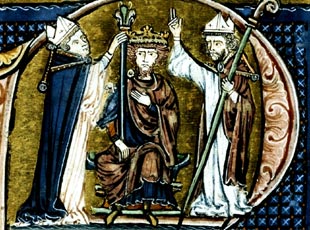
Baldwin I of Jerusalem
Baldwin I (1060s – 2 April 1118) was the first count of Edessa from 1098 to 1100 and king of Jerusalem from 1100 to his death in 1118. He was the youngest son of Eustace II, Count of Boulogne, and Ida of Lorraine and married a Norman noblewoman, Godehilde of Tosny. He received the County of Verdun in 1096, but he soon joined the crusader army of his brother Godfrey of Bouillon and became one of the most successful commanders of the First Crusade.
Baldwin I
1100–1118
25 December 1100
Godfrey of Bouillon (as Defender of the Holy Sepulchre)
1098–1100
Baldwin II
c. 1060
2 April 1118
Al-Arish, Fatimid Caliphate
- Godehilde of Tosny
- Arda
- Adelaide del Vasto
While the main crusader army was marching across Asia Minor in 1097, Baldwin and the Norman Tancred launched a separate expedition against Cilicia. Tancred tried to capture Tarsus in September, but Baldwin forced him to leave it, which gave rise to an enduring conflict between them. Baldwin seized important fortresses in the lands to the west of the Euphrates with the assistance of local Armenians. Thoros of Edessa invited him to come to Edessa to fight against the Seljuks. Taking advantage of a riot against Thoros, Baldwin seized the town and established the first Crusader state on 10 March 1098. To strengthen his rule, the widowed Baldwin married an Armenian ruler's daughter (who is now known as Arda). He supplied the main crusader army with food during the siege of Antioch. He defended Edessa against Kerbogha, the governor of Mosul, for three weeks, preventing him from reaching Antioch before the crusaders captured it.
Godfrey of Bouillon, whom the crusaders had elected their first ruler in Jerusalem, died in 1100. Daimbert, the Latin patriarch, and Tancred offered Jerusalem to Tancred's uncle, Bohemond I of Antioch. Godfrey's retainers took possession of the town and urged Baldwin to claim Godfrey's inheritance. Since a Muslim ruler had captured Bohemond, Baldwin marched to Jerusalem meeting little resistance. The Patriarch crowned him king in Bethlehem on 25 December. He captured Arsuf and Caesarea in 1101, Acre in 1104, Beirut in 1110, and Sidon in 1111, with the assistance of Genoese and Venetian fleets and of several smaller crusader groups, but all his attempts to capture Ascalon and Tyre failed. After his victory at the third battle of Ramla in 1105, the Egyptians launched no further major campaigns against the Kingdom of Jerusalem.
Baldwin helped Bertrand, Count of Toulouse, to capture Tripoli in 1109. Being the only crowned monarch in the Latin East, Baldwin claimed suzerainty over other crusader rulers. Baldwin II of Edessa and Bertrand swore fealty to him. Tancred, who ruled the Principality of Antioch, also obeyed his summons. Baldwin supported Baldwin II and Tancred against Kerbogha's successor, Mawdud, who launched a series of campaigns against Edessa and Antioch in the early 1110s. He erected fortresses in Oultrejordain—the territory to the east of the Jordan River—to control the caravan routes between Syria and Egypt. He died during a campaign against Egypt.
Count of Edessa[edit]
Establishment[edit]
The Armenians regarded Baldwin as a liberator.[64][65] Two Armenian chiefs, Fer and Nicusus, joined him soon after he started his campaign.[66][67] The local population massacred the Seljuk garrisons and officials, or forced them to flee.[66] The Seljuks' fear of the crusaders contributed to Baldwin's success.[68] He seized two important fortresses, Ravendel and Turbessel, without a fight before the end of 1097.[66][68] He made Bagrat the governor of Ravendel,[68] and appointed Fer to administer Turbessel.[66]
The Armenian lord of Edessa, Thoros, sent envoys—the Armenian bishop of Edessa and twelve leading citizens—to Baldwin in early 1098, seeking his assistance against the nearby Seljuk rulers.[62][68][69] Being the first town to convert to Christianity, Edessa had played an important role in Christian history.[45] Before departing for Edessa, Baldwin ordered the arrest of Bagrat, whom Fer had accused of secret correspondence with the Seljuks.[67][70] Bagrat was tortured and forced to surrender Ravendel.[67][71] Baldwin left for Edessa in early February, but troops sent by Balduk, the emir of Samosata,[70] or Bagrat[72] prevented him from crossing the Euphrates. His second attempt was successful[72] and he reached Edessa on 20 February.[73][74] Baldwin did not want to serve Thoros as a mercenary.[75][76] The Armenian townspeople feared that he was planning to leave the town, so they persuaded Thoros to adopt him.[77] Alone among the contemporary historians of the First Crusade, Albert of Aix claims that the local customs of adoption required Thoros to take Baldwin under his shirt.[78] Strengthened by troops from Edessa, Baldwin raided Balduk's territory and placed a garrison in a small fortress near Samosata.[79]